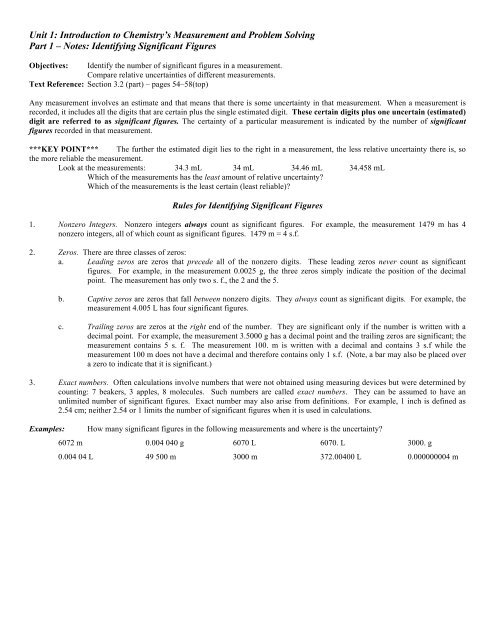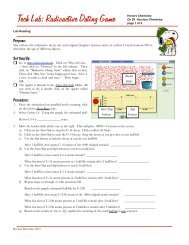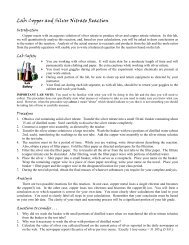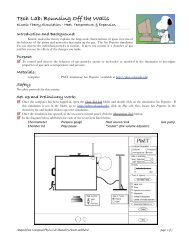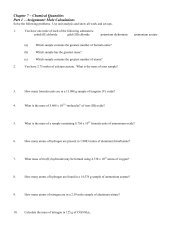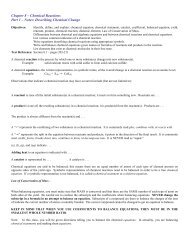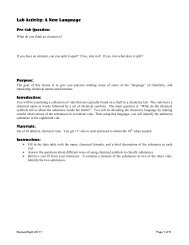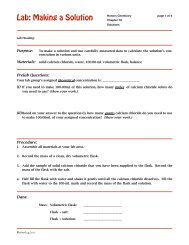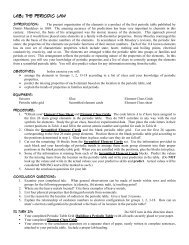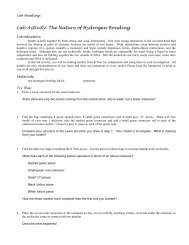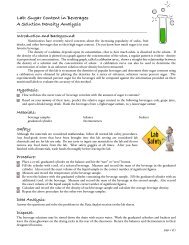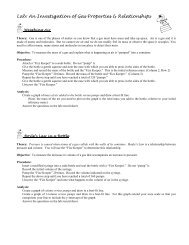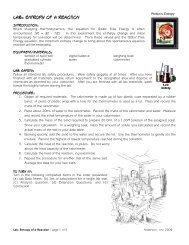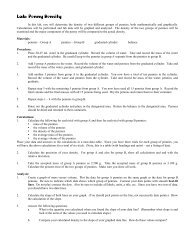Unit 1 Notes - Honors Chemistry Coursework
Unit 1 Notes - Honors Chemistry Coursework
Unit 1 Notes - Honors Chemistry Coursework
Create successful ePaper yourself
Turn your PDF publications into a flip-book with our unique Google optimized e-Paper software.
<strong>Unit</strong> 1: Introduction to <strong>Chemistry</strong>’s Measurement and Problem SolvingPart 3 – <strong>Notes</strong>: Mathematical Operations and Significant Figures – 2Objectives: Correctly record an answer to multiple-step math problems, averages, and conversions with the appropriate numberof significant figures. Additional objective – see objectives from <strong>Unit</strong> 1 Part 2.Text Reference: Section 3.2 – pages 54-62Rule 1: Multiplication, Division, and Exponent Operations, only:When multiplying, dividing, and using exponents only, perform all operations first and then apply the rule for significantfigures to the answer.Example 1: (2.48 m) 2 (2.58 m) ÷ 5.78 mRule 2: Addition and/or Subtraction in combination with other operations:When addition or subtraction operations are used in conjunction with other operations, follow the algebraic order ofoperations, applying the rules of significant figures after addition/subtraction is completed. Then perform themultiplication/division as necessary and then apply the rules for significant figures, again.Example 2: (4.238 m + 5.97 m) ÷ 2.5 sExample 3:[(4.56 m + 5.679 m) (2.00 m + 9 m)] ÷ 27.9 mRule 3: Numbers with NO uncertainty:All conversion fractions, constants, and numbers with no uncertainty are treated as if they have an infinite number ofsignificant figures. More on this part later.Example 4: Convert 14.75 hours to seconds.Rule 4: Averages and uncertainty:When finding the average (mean) of measurements, the mean cannot be more certain than the least certain measurement.Also, keep in mind that you are adding and dividing (two different significant figure rules).Example 5: Calculate the mean of the following measurements: 2.784 g and 9.863 g.
Example 3:Change the following to correct scientific notation:(a) 10x10 7 (b) 0.0050x10 6(c) 303x10 -4 (d) 0.012x10 -7Example 4:Change the following coefficients so they match the exponents that are given.(a) 4.98x10 6 = _______________x10 3 (b) 5.686x10 8 = _______________x10 10(c) 6.37x10 -4 = _______________x10 -7 (d) 3.587x10 -7 = _______________x10 -5Multiplication and Division with Scientific NotationTo multiply numbers in scientific notation, you need to multiply the coefficient portions and the exponent portions separately. Tomultiply the exponential portions, the exponents are algebraically added. (Be aware of signs!) For example:(2.0x10 3 ) x (4.0x10 2 ) =To divide number in scientific notation, you divide the coefficients portions and the exponent portions separately. To divide theexponential portions, the exponents are algebraically subtracted. (Be aware of the signs!) For example:(6.0x10 5 ) ÷ (2.0x10 3 ) =Often, when dividing and multiplying, the product or quotient will be a number greater than or equal to ten or less than one. Whenthis happens, you need to adjust the coefficient so it is a number greater than or equal to 1 but less than 10. You then need to adjustthe exponent so the value of the answer is not changed. Your final answer always needs to be in proper scientific notation.Addition and Subtraction with Scientific NotationWhen we add or subtract numbers in exponential notation, the exponents must be the same. This rule is the same as making sure thedecimals of your numbers you add or subtract are aligned. The answer is the sum or difference of the coefficients with the sameexponent as each number in the problem. Remember, the final answer needs to be in correct scientific notation form.Example 5:Perform the following operations.(a) (3.0x10 6 ) (5.0x10 3 ) = (b) (4.25x10 -5 ) (7.7x10 2 ) =(c) (5.0x10 3 ) ÷ (6.75x10 5 ) = (d) (2.5x10 -5 ) ÷ (5.6x10 -2 ) =(e) (3.45x10 6 ) + (4.56x10 7 ) = (f) (2.45x10 -4 ) + (3.75x10 -2 ) =(g) (2.98x10 5 ) – (3.25x10 4 ) = (h) (9.68x10 -3 ) – (4.67x10 -4 ) =
<strong>Unit</strong> 1: Introduction to <strong>Chemistry</strong>’s Measurement and Problem SolvingPart 7 – <strong>Notes</strong>: Accuracy and PrecisionObjectives: Define, explain, and distinguish between accuracy and precision.Calculate the absolute and relative error and the absolute and relative deviation of a set of measurements.Text Reference: Section 3.2 – pages 54-55Two important factors to consider in measurement are precision and accuracy. They are NOT the same thing.Precision indicates the reproducibility of a measurement.Example: Imagine you took three readings on a thermometer to try to determine the boiling point of pure isopropyl alcohol(rubbing alcohol) at sea level. The results of your trials were 79.3 o C, 79.2 o C, and 79.7 o C. Note how close the measurements are toone another. The measurements show a high degree of reproducibility, they are precise.Accuracy indicates how close a measurement is to its accepted value.Consider the boiling point of pure isopropyl alcohol at sea level, from the example above. It is an accepted fact that pureisopropyl alcohol at sea level boils at 82.5 o C. The three measurements above, although precise, are not close to the accepted value.They are not accurate.Determining Accuracy – Calculating Percent ErrorRecall, accuracy deals with how close measurements are to the accepted or actual value, so you will be comparing the measurementsto the accepted value.Formula for Absolute Error:(also called experimental error)Formula for Percent Error:(also called relative error)From the example above we have three different values: 79.3 o C, 79.2 o C, and 79.7 o C.Calculate the percent error for each individual measurement:Then calculate the average of those measurements:You can also calculate the percent error for the mean of the measurements:What is the mean of the measurements?What is the percent error for the mean of the measurements?
Determining Precision – Calculating DeviationCalculating how precise measurements are is a multi-step process. You will again use the three temperature readings for the boilingisopropyl alcohol example at the beginning of the notes to complete the steps that follow. Recall, precision deals with how closemeasurements are to one another, so you will be looking at comparing the measurements to the average.STEP 1:Determine the Mean of the measurements.STEP 2:Calculate the Absolute Deviation for EACH measurement. In this step we are determining how much eachindividual measurement deviates from the average.STEP 3:Calculate the Average Absolute Deviation.STEP 4:Express the measurement in terms of Mean ± Average Absolute Deviation.STEP 5:Calculate the Relative Deviation. (Also referred to as percent deviation.)STEP 6:Express the measurement in terms of Mean ± Relative Deviation.


